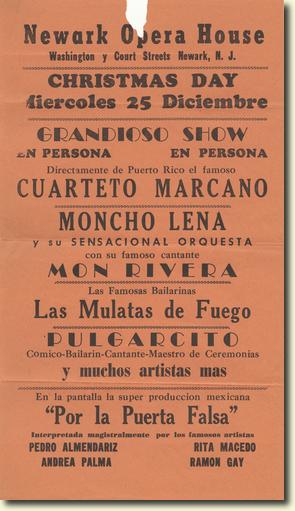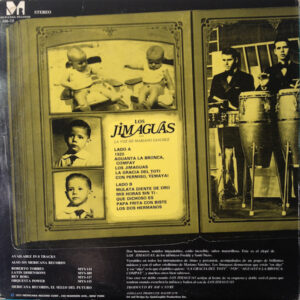A Century of Cuban Music in New Jersey
Ben Lapidus
 I started playing Cuban music in New Jersey in the 1990s, and that’s when I really began hearing about the “golden days” of Cuban music in Hudson County. Years later, I would write a history of Latin music in New York City, but I didn’t think of separating the history of New York and New Jersey, musically speaking. In other publications, I also considered Hudson County, Elizabeth, and Newark to be close enough to New York to be included in discussions of activities by New York-based musicians. I had not dedicated much effort to differentiate between these locales and New York City in my own research. Events that happened in New Jersey have been misattributed to New York City possibly because New Jersey’s geography is unfamiliar to outsiders and New York is iconic, particularly in the history of Latin music. Such is the case with some of the emblematic 1920s RCA-Victor recordings made by El Sexteto Habanero and Trio Matamoros in Camden, NJ. Taking all of this into consideration, we can see that no matter what happened in New York City, New Jersey Cubans proudly expressed their musical cubanía and continued performing and recording a variety of Cuban music genres for largely Cuban audiences in a wide variety of settings within the Cuban community of Hudson County, as well as in Elizabeth, Newark, and elsewhere in the Garden State. With my research, I hope to correct that oversight by enumerating and exploring many New Jersey-based musicians, recording studios, venues, and events so inextricably linked with Cuban music.
I started playing Cuban music in New Jersey in the 1990s, and that’s when I really began hearing about the “golden days” of Cuban music in Hudson County. Years later, I would write a history of Latin music in New York City, but I didn’t think of separating the history of New York and New Jersey, musically speaking. In other publications, I also considered Hudson County, Elizabeth, and Newark to be close enough to New York to be included in discussions of activities by New York-based musicians. I had not dedicated much effort to differentiate between these locales and New York City in my own research. Events that happened in New Jersey have been misattributed to New York City possibly because New Jersey’s geography is unfamiliar to outsiders and New York is iconic, particularly in the history of Latin music. Such is the case with some of the emblematic 1920s RCA-Victor recordings made by El Sexteto Habanero and Trio Matamoros in Camden, NJ. Taking all of this into consideration, we can see that no matter what happened in New York City, New Jersey Cubans proudly expressed their musical cubanía and continued performing and recording a variety of Cuban music genres for largely Cuban audiences in a wide variety of settings within the Cuban community of Hudson County, as well as in Elizabeth, Newark, and elsewhere in the Garden State. With my research, I hope to correct that oversight by enumerating and exploring many New Jersey-based musicians, recording studios, venues, and events so inextricably linked with Cuban music.
Today, the area remains home to a who’s who of Cuban folkloric and popular musicians who have been arriving since the 1990s and I have personally been very fortunate to have shared the bandstand and many insightful conversations with musicians such as Ogduardo “Román” Díaz, Mauricio Herrera Tamayo, Ariacne Trujillo Duran, Pedrito Martínez, Daymar Calvario, Manuel Alejandro Carro, Jorge Bringas, Lisandro and Igor Arias, Lino Fernández, David Oquendo, Yuniel Jiménez, Julian Chang, José “Pepito” Gómez, and many others who continue to arrive today. Each of these musicians and friends arrived at different times, but they personally lifted the bar of musical greatness for the rest of us to aspire to.
Before the arrival of the aforementioned musicians in the 1990s, New Jersey had been the home base for countless other internationally known Cuban musicians such as Celia Cruz, Fernando Lavoy and Juan González (Los Soneros), Ernest “Chico” Álvarez Peraza, Paquito D’Rivera, El Conjunto Crema, Conjunto Son Moderno, Charanga 76, Charanga Creación, Orquesta Zodiacal, Orquesta Riviera, Orlando Contreras, The Cano sisters, Facundo Rivero, Regino Tellechea, Oscar Oñoz, Gabriel Machado, Juan Pablo Torres, and so many other musicians who arrived prior, during, and after the Cuban revolution. This generation established Cuban music in New Jersey. 43rd Street and Bergenline Avenue in West New York is also called Celia Cruz Way, and this was the original location of the Cuban music scene from the 1960s to the 1980s. Cuban artists, through successive waves of immigration, established a rich legacy of Cuban music in New Jersey since the 1920s, never missing the latest musical trends. All of that history is incredibly rich and detailed. My friendships with all of these Cuban musicians in New Jersey and the musical inspiration they give me and so many others is the impetus for my research. It’s an incredible story.
The text is copyrighted by the author, 2025.
Users may cite with attribution.
